A garden bridge isn’t just a way to get over water—it’s an invitation to pause, admire seasonal color, and tie different pockets of your yard into one harmonious whole. Below you’ll find twenty distinct garden bridge ideas, each with its own mood, material palette, and practical value. Whether you favor sleek modern steel or a living willow arch that grows greener every year, these concepts show how thoughtful spans can boost accessibility, add drama, and even nurture wildlife. Read through, pick the personality that matches your landscape, and let the next steps of your garden journey begin.
1. Classic Arched Wooden Garden Bridge
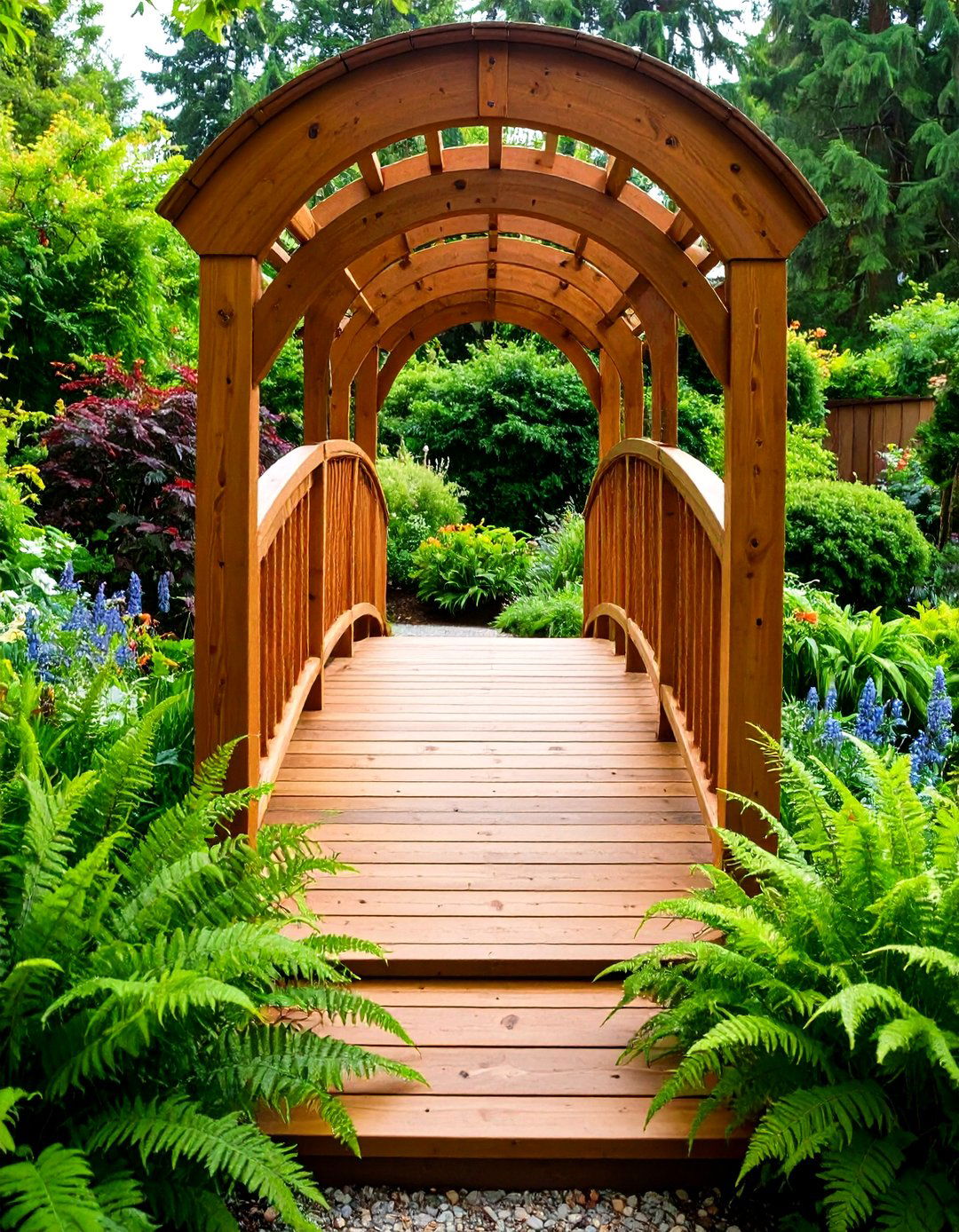
A gentle timber arc instantly signals welcome. Because a wooden garden bridge naturally weathers, it settles into planting schemes and softens bold water-feature lines. Design guides note that bridges “move visitors from one part of the garden to the next” while carrying strong visual weight. Choose rot-resistant cedar or larch and crown the deck slightly so rain sheds off the boards. Shallow footings at each bank avoid root damage, and low, spindle rails keep the look airy. Finish with a penetrative oil rather than film-forming varnish so maintenance is a quick annual wipe-on. Tuck small ferns at the abutments to blur the join between earth and span.
2. Vibrant Japanese-Style Red Garden Bridge
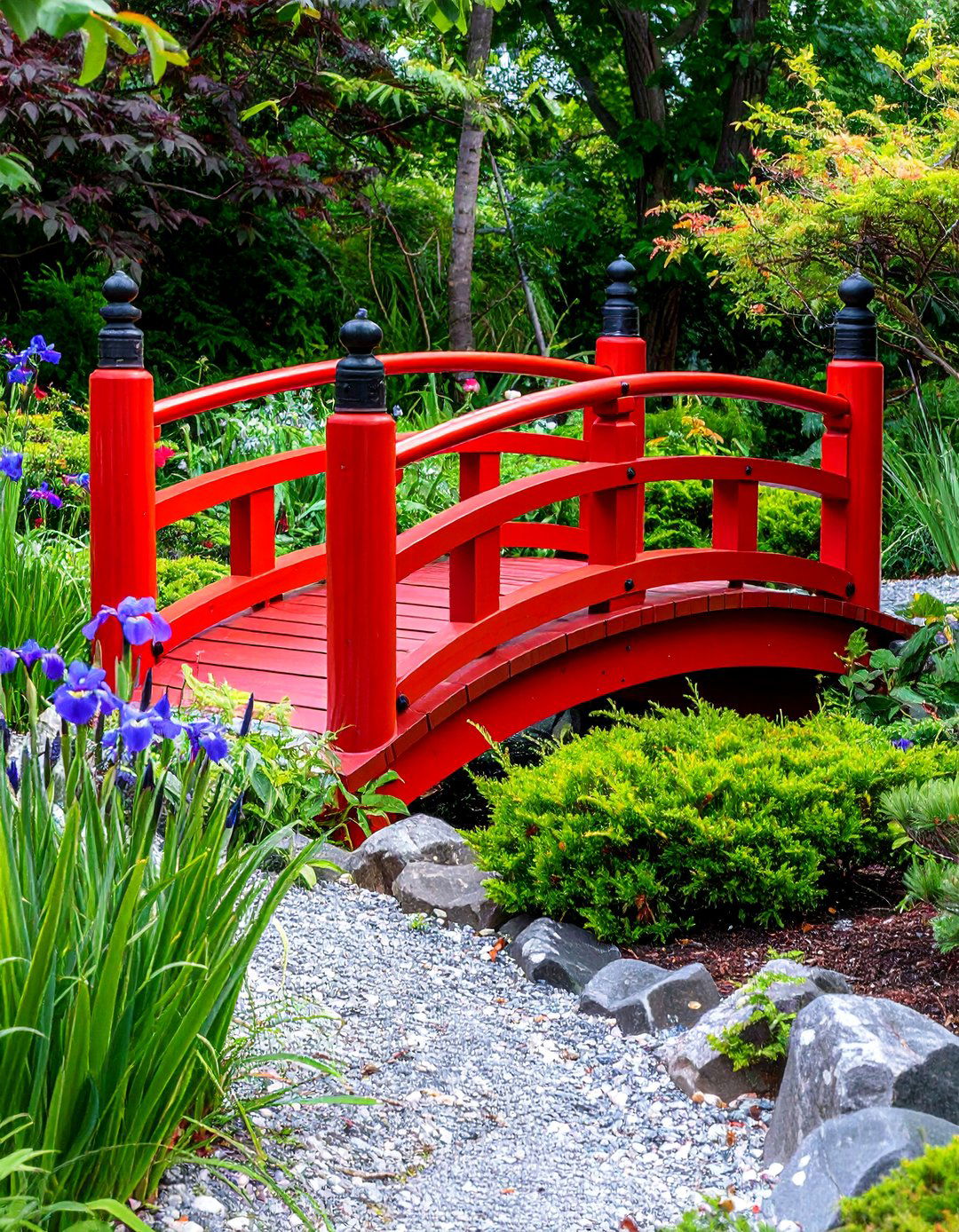
Unlike muted timber, a Japanese-inspired vermilion bridge turns into a sculptural focal point. Traditional Zen gardens list bridges among core elements that symbolize life’s transitions. Pair that symbolism with gently upturned rail posts and layered planting—think iris, dwarf pine, and reflective raked gravel—to echo temple grounds. Keep proportions modest; a 3-metre length suits most ponds without overwhelming plant masses. A marine-grade primer under the red enamel prevents fade, and a matte topcoat avoids distracting glare. Add simple granite lanterns at each landing for dusk ambience that feels timeless rather than theme-park.
3. Sleek Minimalist Steel Garden Bridge
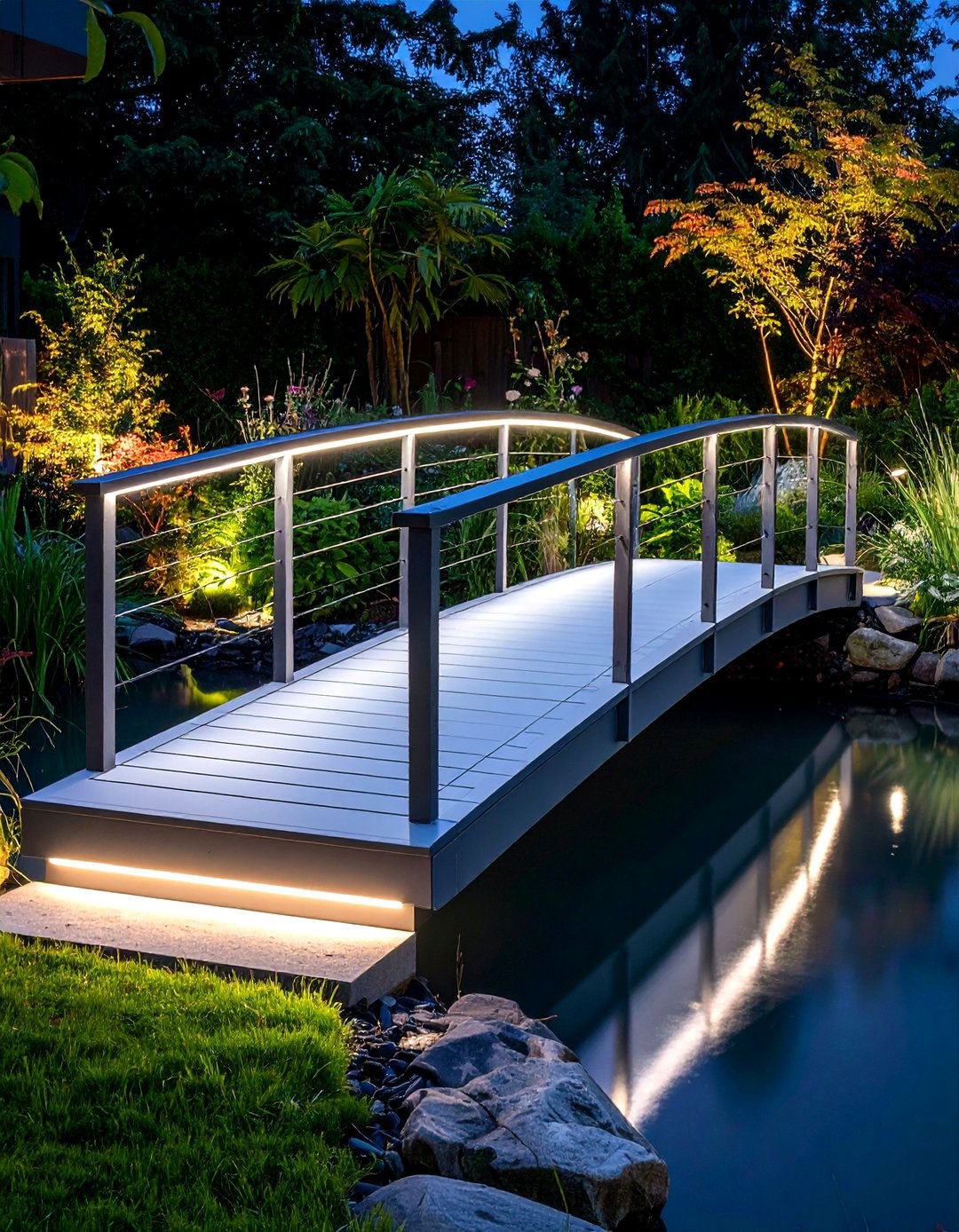
For modern courtyards, a flat, powder-coated steel garden bridge delivers clean geometry. The ultra-thin profile lets water and planting stay centre-stage while still providing sure footing. Contemporary walkway case studies highlight how dark metal strips contrast beautifully with light aggregate or pale paving behind them. Specify anti-slip tread plates or laser-cut drainage slots to keep the deck safe after rain. Because steel allows longer, lighter spans, you can skip mid-stream posts and leave reflective water surfaces undisturbed. Conceal low-voltage LED strip under the in-board handrail for a subtle night glow that doesn’t spoil minimalist lines.
4. Rustic Rope-and-Plank Suspension Garden Bridge

Looking for adventure? A rope-supported garden bridge brings tree-house energy to large, informal plots. A proven DIY project shows how light cable, tensioned dead-men anchors, and spaced timber slats create an 80-foot walking span strong enough to shrug off floods while still swaying delightfully underfoot. Scale the concept down to ten feet for a backyard: two buried posts per bank, 6 mm galvanised wire rope, and pressure-treated 2×6 treads set 25 mm apart for drainage. Wrap the handropes in soft lashing so little hands won’t chafe, and add net-sided rail panels if you need extra security.
5. Upcycled Pallet Wood Garden Bridge
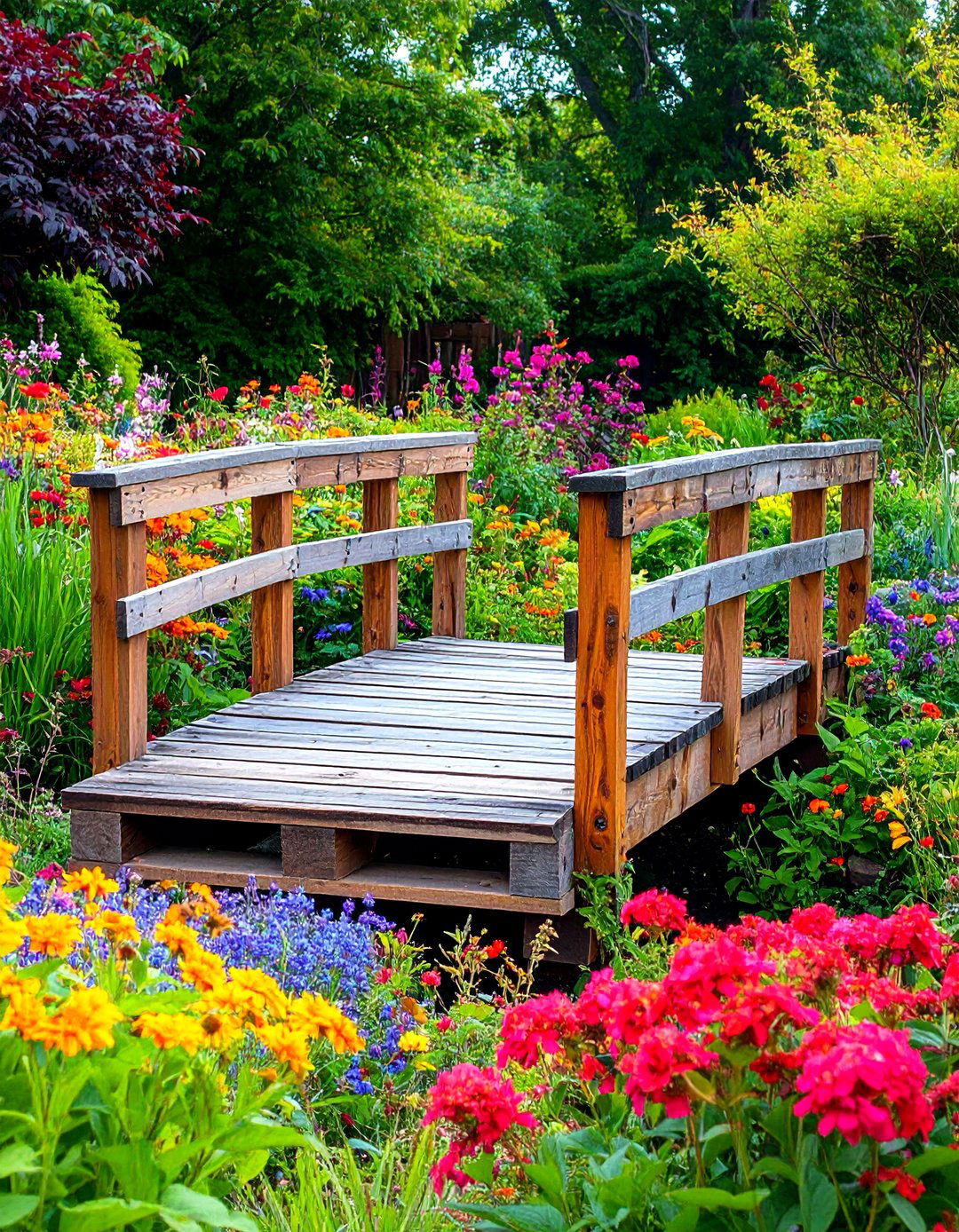
Surprisingly sturdy bridges can start life as shipping pallets. Step-by-step builds show pallet stringers laminated into beams and decked with reclaimed boards for a charming, low-cost footbridge. Sort pallets by HT (heat-treated) stamps to avoid chemical residues, then plane edges lightly; leaving a hint of rough grain keeps the rustic vibe. Two stacked pallets form one side beam; screw them together, flip, and repeat. A centre plank under-brace stops flex and makes the inevitable “jump test” satisfying. Coat everything in an ecological borate solution for bug resistance without altering the weather-silvered patina you’ll grow to love.
6. Railway Sleeper Beam Garden Bridge

If your plot includes a drainage ditch, sleepers offer instant, rugged structure. Wildlife-friendly design advice recommends simply “building a bridge or two out of railway sleepers” to connect zones without filling delicate hollows. Lay two parallel sleepers on compacted gravel pads, drift-pin them together with rebar, and top with a single plank walkway so feet don’t slip between timbers. Because reclaimed sleepers often contain creosote, cap surfaces with cedar planks if children will linger barefoot. Plant moisture-loving ferns or hostas right beside the sleeper ends—the creosote acts as a slug deterrent while the plants hide the chunky beam profile.
7. Living Willow Arch Garden Bridge

A living willow garden bridge combines sculpture, shade, and ecological flair. Guides to willow structures show how quickly hybrid rods can be woven over a lightweight frame, rooting in situ for under $50 in material cost. Start with 2-metre whips, cross-planting them opposite each other on each bank and bending them into gothic arches; tie with biodegradable twine. Within two seasons the stems self-graft, creating a green roof that hums with hoverflies by midsummer. Annual coppice keeps the crown light, and any pruned rods become next year’s stakes. A bark-mulched path beneath stays cool even on high-sun afternoons.
8. Flood-Proof Gabion Garden Bridge
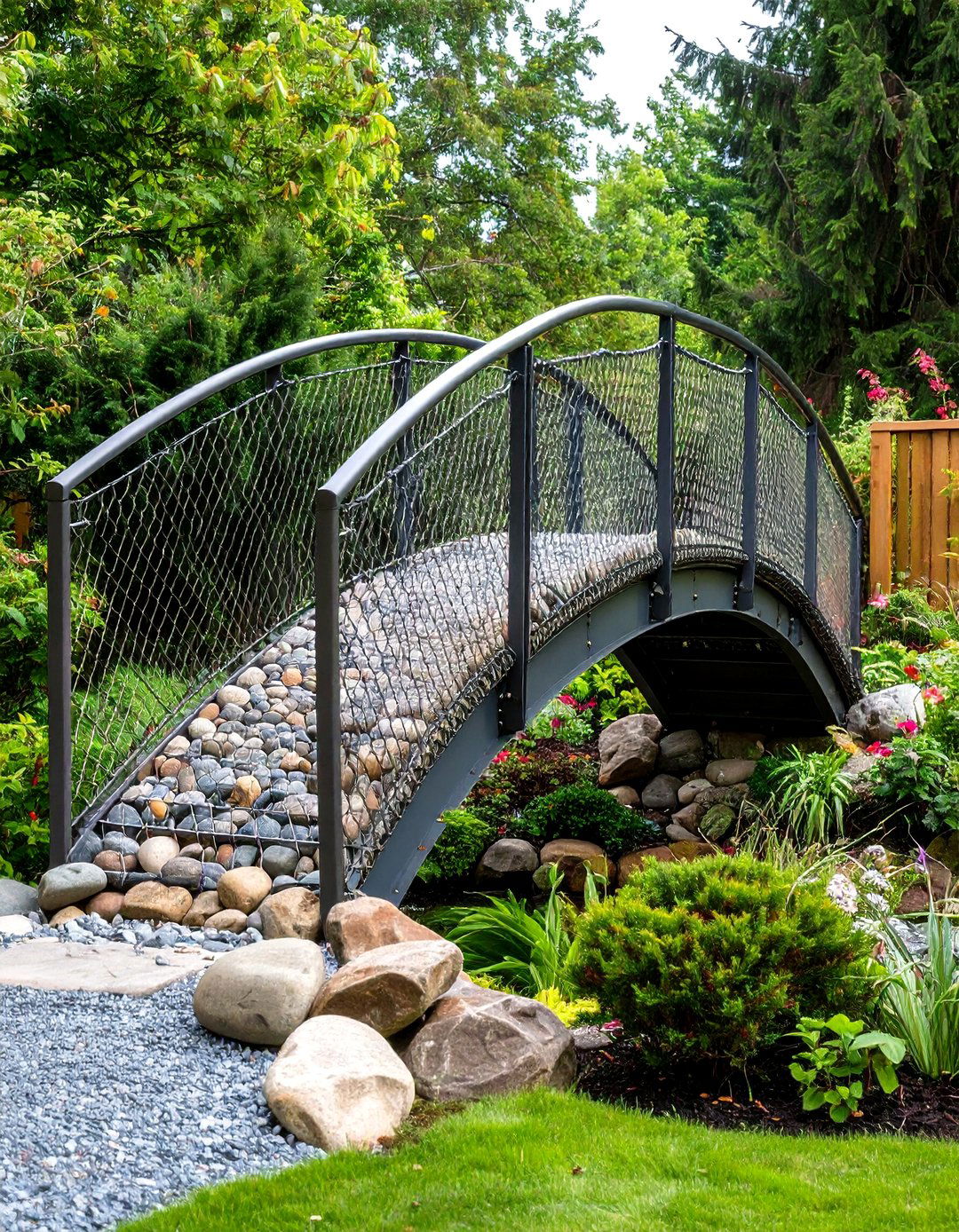
Where banks erode or flashy streams rage in monsoon season, gabion basket foundations underpin a resilient garden bridge. Stone-filled mesh bases rated to last 30 years in fresh water can shield timber or metal decks from scouring currents. Stack three rows of 750 mm-high cages on each side, knitting baskets together with helical ties. Bed a steel H-beam across the tops and bolt your chosen deck above flood level. The rock faces double as handsome retaining walls and habitats for mosses and lizards. For a textural twist, grade river stones from fist-size at the bottom to decorative pebbles on the visible top layer.
9. Pergola-Topped Garden Bridge Retreat
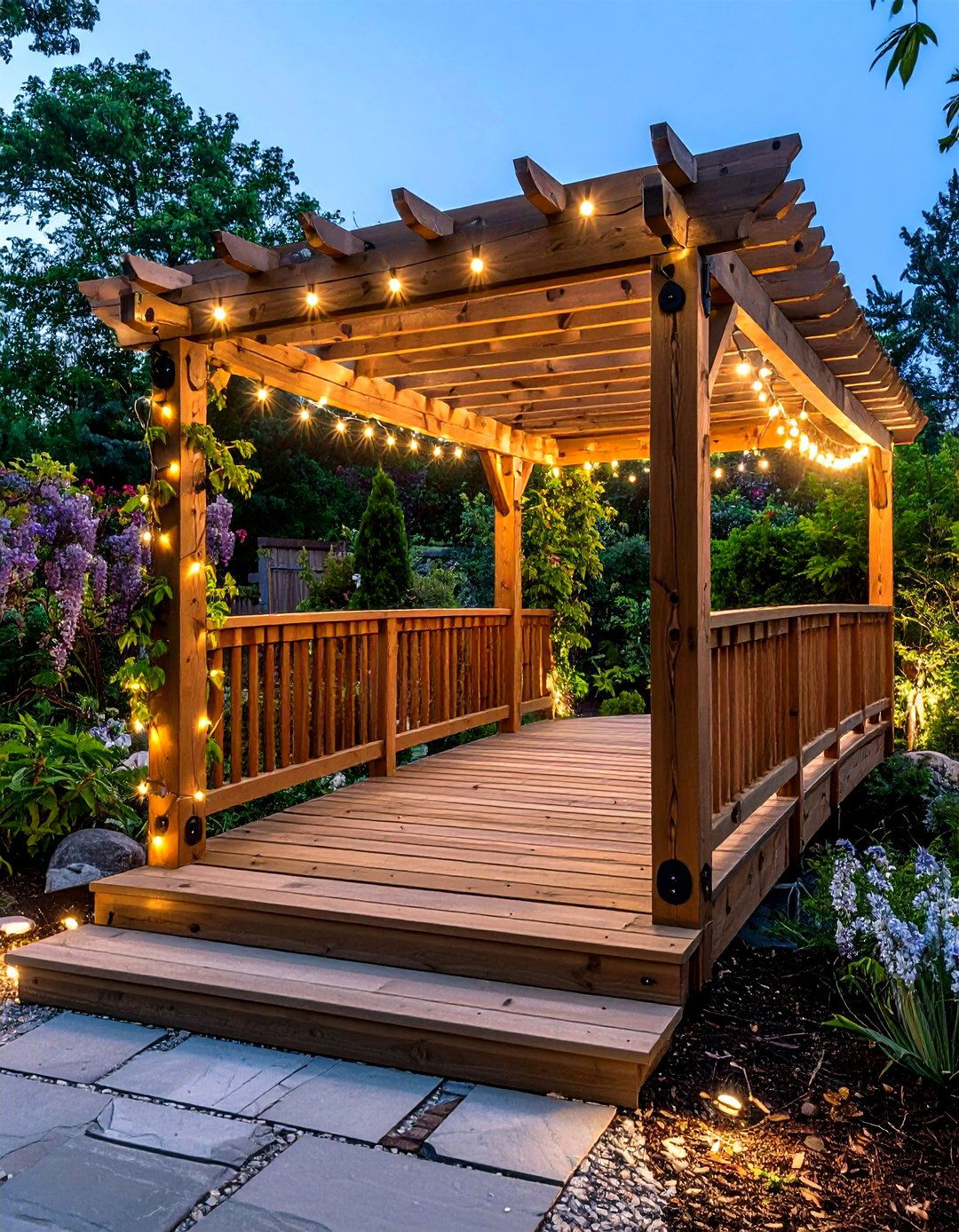
Bringing overhead structure onto a garden bridge turns a simple crossing into a shady destination. Photo-led case studies of quarry-inspired show gardens use chunky slate stepping bridges leading to sheltered terraces. Adapt that idea with a cedar pergola frame bolted to hidden steel shoes inside the deck joists. Train scented climbers—jasmine, wisteria, even dwarf grapes—along the rafters so each crossing bathes you in seasonally shifting fragrance. Keep rafters narrow (38 × 90 mm) and spaced 200 mm apart so the span still feels open to sky. Underlight rafters with festoon bulbs for magical reflections at dusk.
10. Solar-Lit Night-Safety Garden Bridge
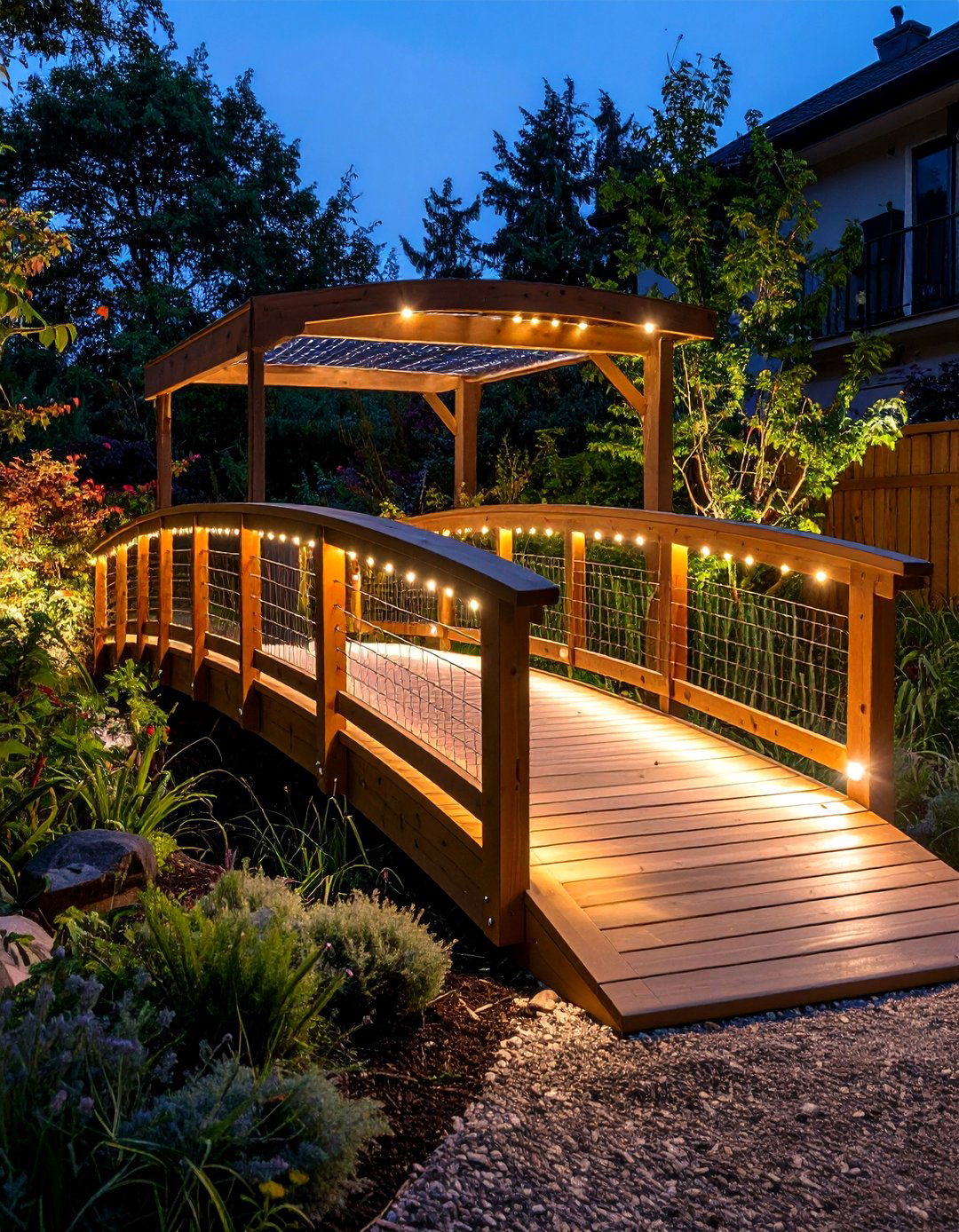
Good lighting doubles a bridge’s usefulness after sunset and avoids cable trenching headaches. Outdoor electrical guides recommend spacing solar path lights about 6–8 feet apart for even illumination along a walkway. Recent consumer tests show integrated-panel stake lights now run eight hours on a single summer charge and cost as little as $2.50 during seasonal sales. Clip fixtures to the handrail instead of the deck so panels stay sun-kissed. Choose warm-white LEDs (2700 K) to keep night insects comfortable and avoid bluish glare over water. A tiny dusk sensor means the garden bridge automatically greets evening visitors with a low, welcoming glow.
11. Contemporary Cable-Stayed Garden Bridge
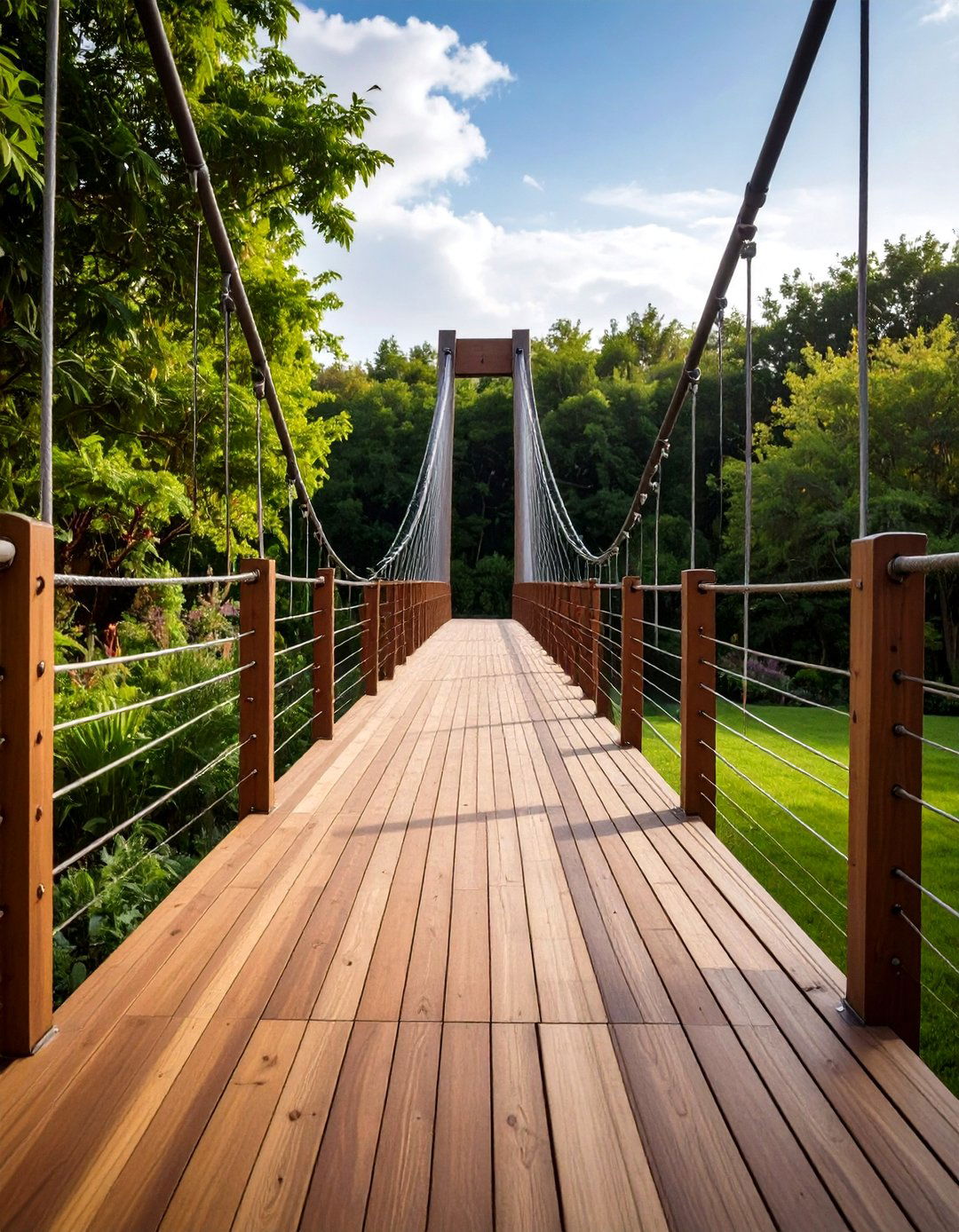
Borrowing from city landmarks, a mini cable-stayed garden bridge pairs engineering drama with slender elegance. DIY tutorials detail how small-scale stays, dead-men anchors, and crowned decks create long spans with minimal piers. Angle stainless cables from a single off-centre mast, balancing the deck in tension. Use thin hardwood boards laid perpendicular to the run so they visually lengthen the walkway. Because the deck is lightly cambered, puddles roll off and the bridge feels springy but safe. Stainless turnbuckles let you tune sag each spring after frost heave, keeping lines taut and architectural.
12. Compact Cantilevered Stream-Side Garden Bridge

When space behind the bank is tight, a cantilevered platform jutting 1.5 metres over water can function as a micro-bridge and fishing perch. Anchor two parallel steel box-sections into a concrete pad set back from the edge, then lay a floating hardwood deck that appears to levitate above the flow. This approach keeps both banks untouched for planting while providing access to the centreline of the stream. Add an L-shaped bench that doubles as safety rail. Use dark stain underneath and lighter planks on top so the structure visually thins out toward the water.
13. Pebble Mosaic Garden Bridge Path
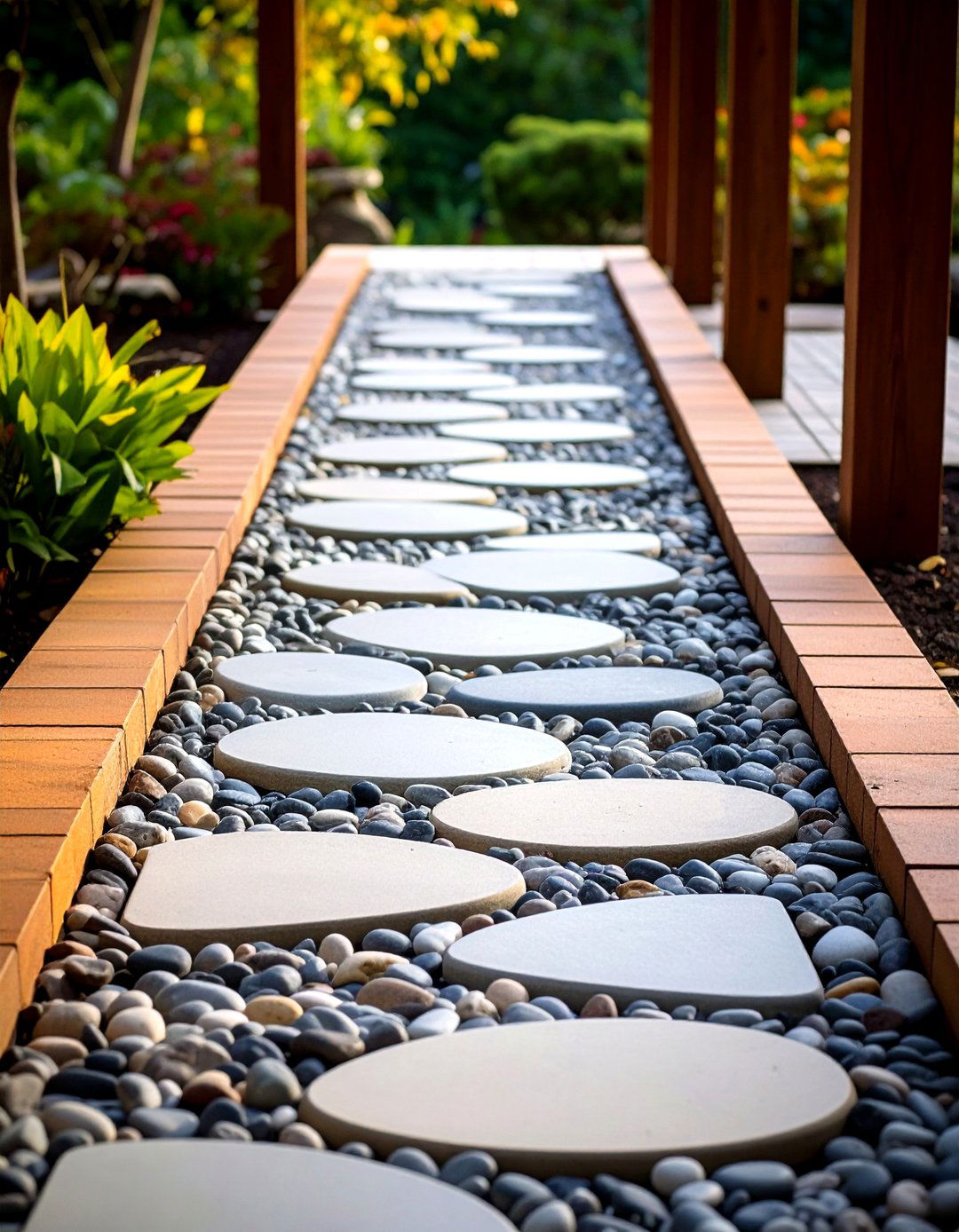
For cottage gardens, a low pebble mosaic bridge blends art underfoot with function. Lay a shallow reinforced-concrete slab between banks, then set river pebbles upright into a 20 mm mortar bed, grading colours into flowing leaf or wave patterns. Walkway design references highlight how texture invites slower pacing, letting visitors savour surrounding blooms. Seal with breathable siloxane so frost can’t creep under stones. Edge the slab with reclaimed brick soldier courses to stop pebbles creeping. Because the deck sits almost flush with the lawn, mowers can pass over without scalping, and wheelbarrows roll easily.
14. Fold-Away Drawbridge for Small Ponds
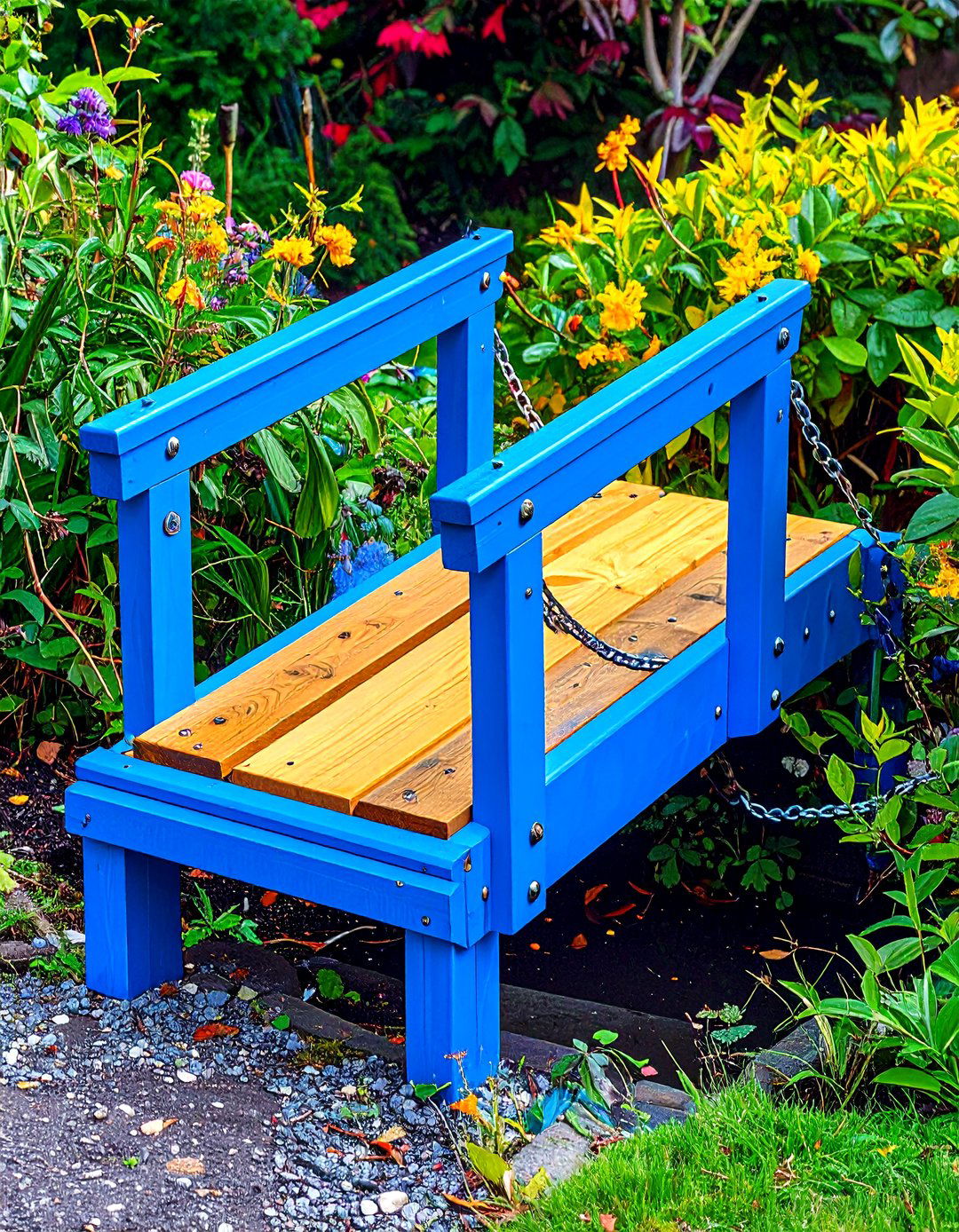
Tiny wildlife ponds often need occasional access for netting leaves. A fold-away mini drawbridge solves the space puzzle: hinge a single cedar plank to one bank and support the free end with lightweight chain. A discreet cleat lets you winch the bridge upright against a post when you need open water. Attach a rubber bumper strip where the plank meets the opposite stone so fish don’t hear a loud thud. Because the deck spends half its life drying vertically, rot risk stays low and annual oiling becomes a two-minute task.
15. Child-Friendly Play Rope Garden Bridge
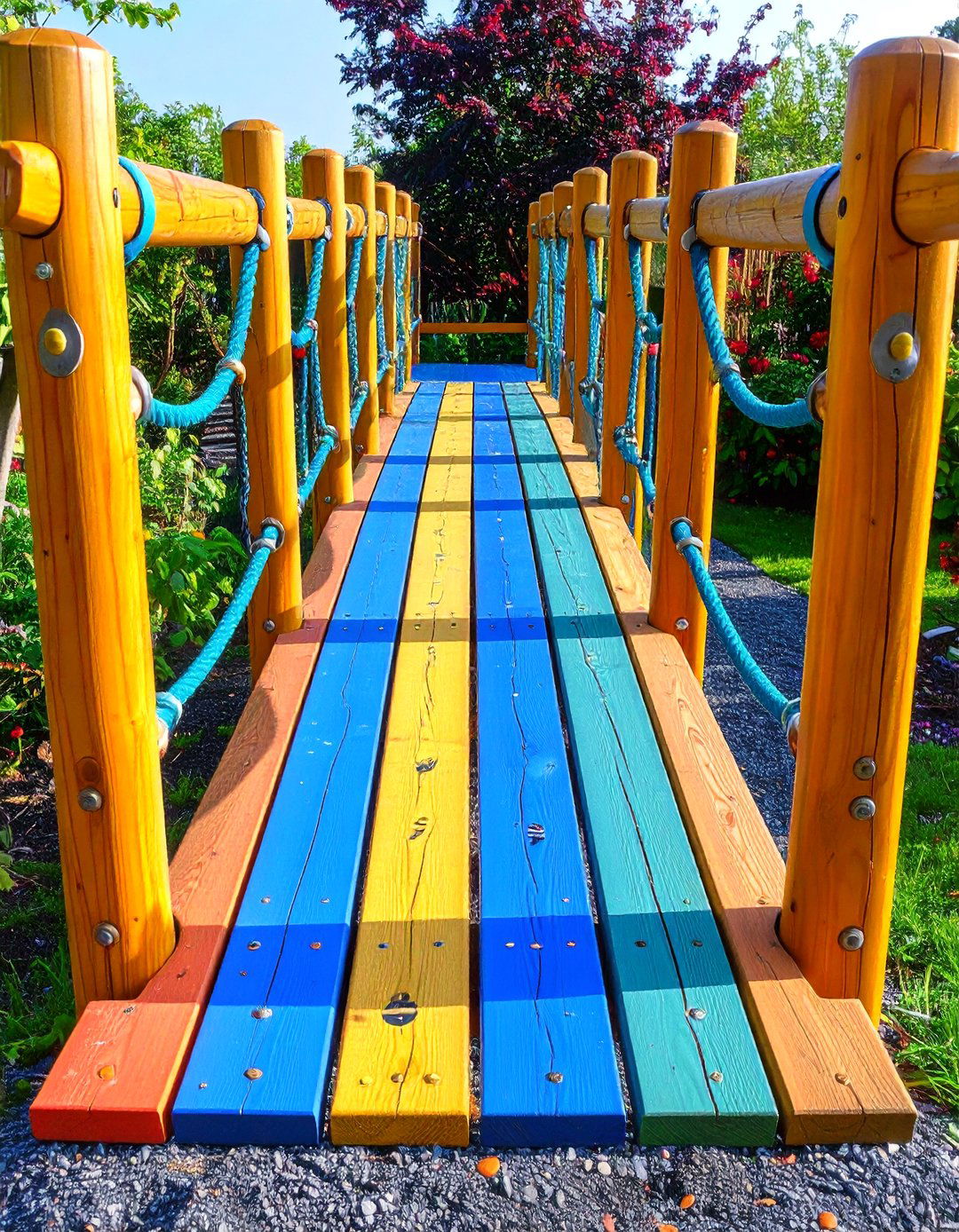
For family zones, a short low-rope garden bridge over a dry-riverbed inspires imagination games. Rope-bridge project boards show timber side rails paired with knotted polypropylene for safe, bouncy crossings that sharpen balance skills. Sink 100 mm posts 600 mm deep and cap with smooth ball finials; thread the handropes through recessed eye-bolts so metal is hidden from small fingers. Deck with 35 mm-thick larch slats spaced just 10 mm so toys don’t vanish between gaps. Paint the rails in bright eco enamel and stencil footprint trails to spark nature scavenger hunts.
16. Tranquil Zen Rock Garden Bridge

A slender, low garden bridge skimming raked gravel completes a contemplative Zen corner. Articles on mindful landscapes emphasise that bridges in a rock garden should feel like effortless transitions between symbolic islands of thought. Keep the deck only 40 mm above the gravel so it seems to float, and forego handrails unless local codes demand them. Use unstained cypress so the pale wood echoes sand tones. Once a season, lift the deck, rake new patterns, then replace—an act of quiet maintenance that becomes moving meditation in its own right.
17. Wildlife Corridor Log Garden Bridge
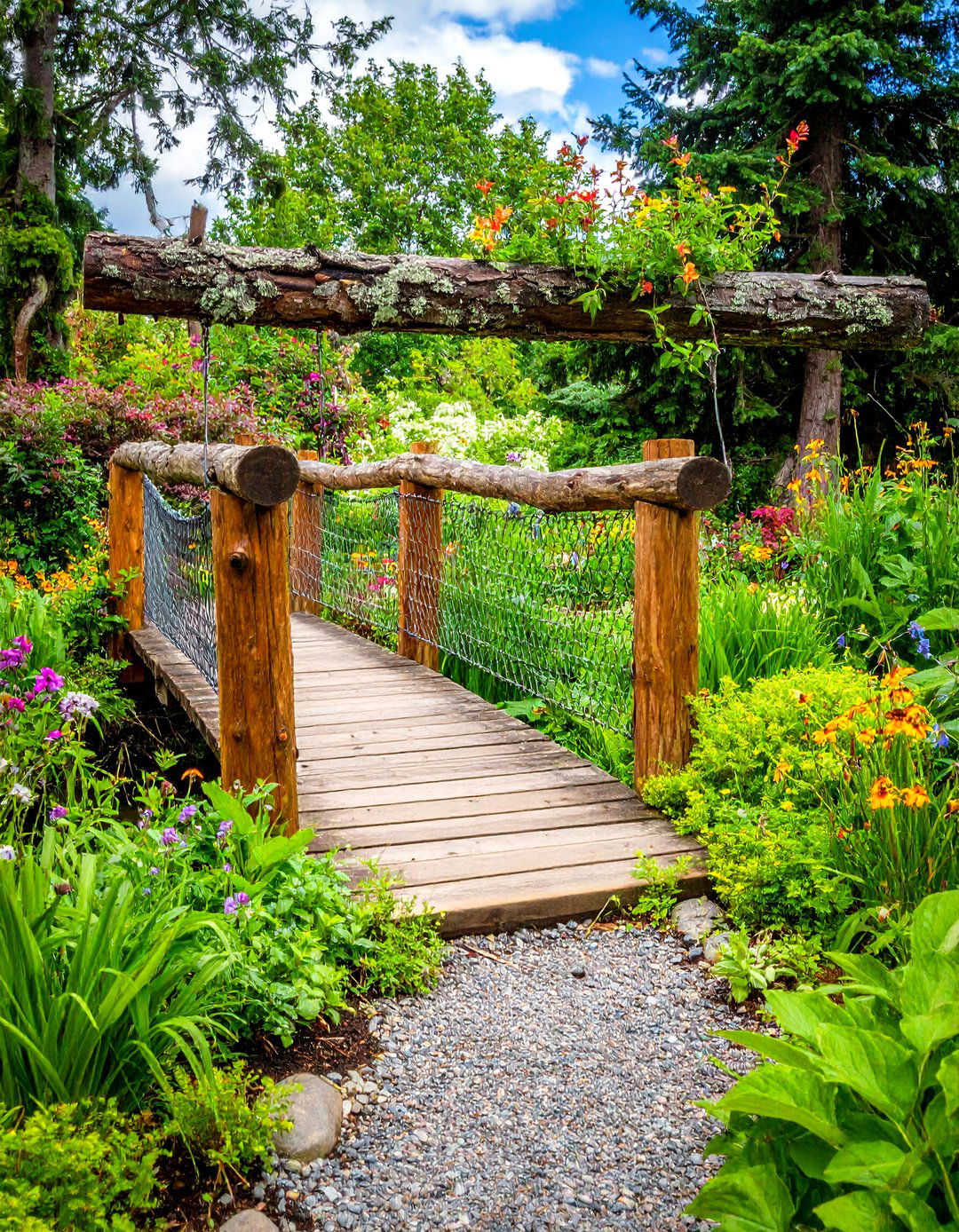
Sometimes the simplest bridge is also the most biodiverse. Strip bark from a storm-felled trunk, rest it across a shallow brook, and secure it with rebar stakes driven through pre-drilled holes. Leave one side rough-hewn; insects will burrow, and lichens soon colonise. Add a thin chicken-wire overlay for grip where feet tread. By keeping span height low, hedgehogs and amphibians can cross safely beneath while you cross on top. Regularly check for rot at bank ends and roll in a fresh log every five to seven years to keep the habitat cycle turning.
18. Sculptural Corten Steel Garden Bridge
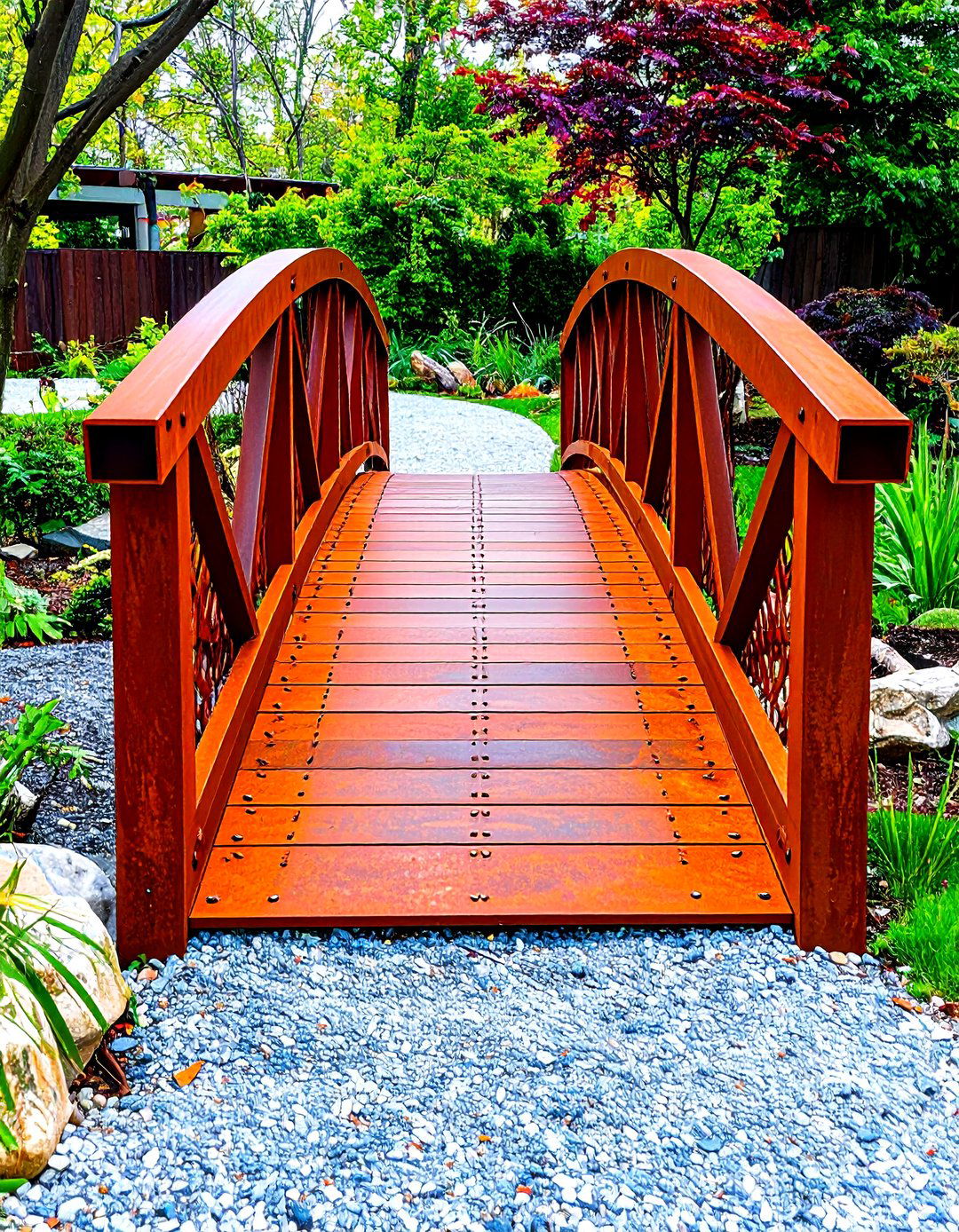
Weathering steel ages from charcoal to warm rust, offering both structure and sculpture. Fabricate a single 8 mm-thick Corten plate laser-cut with leaf motifs; when installed over a koi pond the cut-outs project dancing light onto water beneath. Because the alloy forms a protective oxide, no painting is required—just rinse first-year runoff away from delicate plants. Weld 50 mm angle returns under each edge for stiffness, eliminating visible joists. Pair with minimalist gravel banks for a gallery-like feel that still echoes natural earthy tones.
19. Floating Deck-Style Garden Bridge
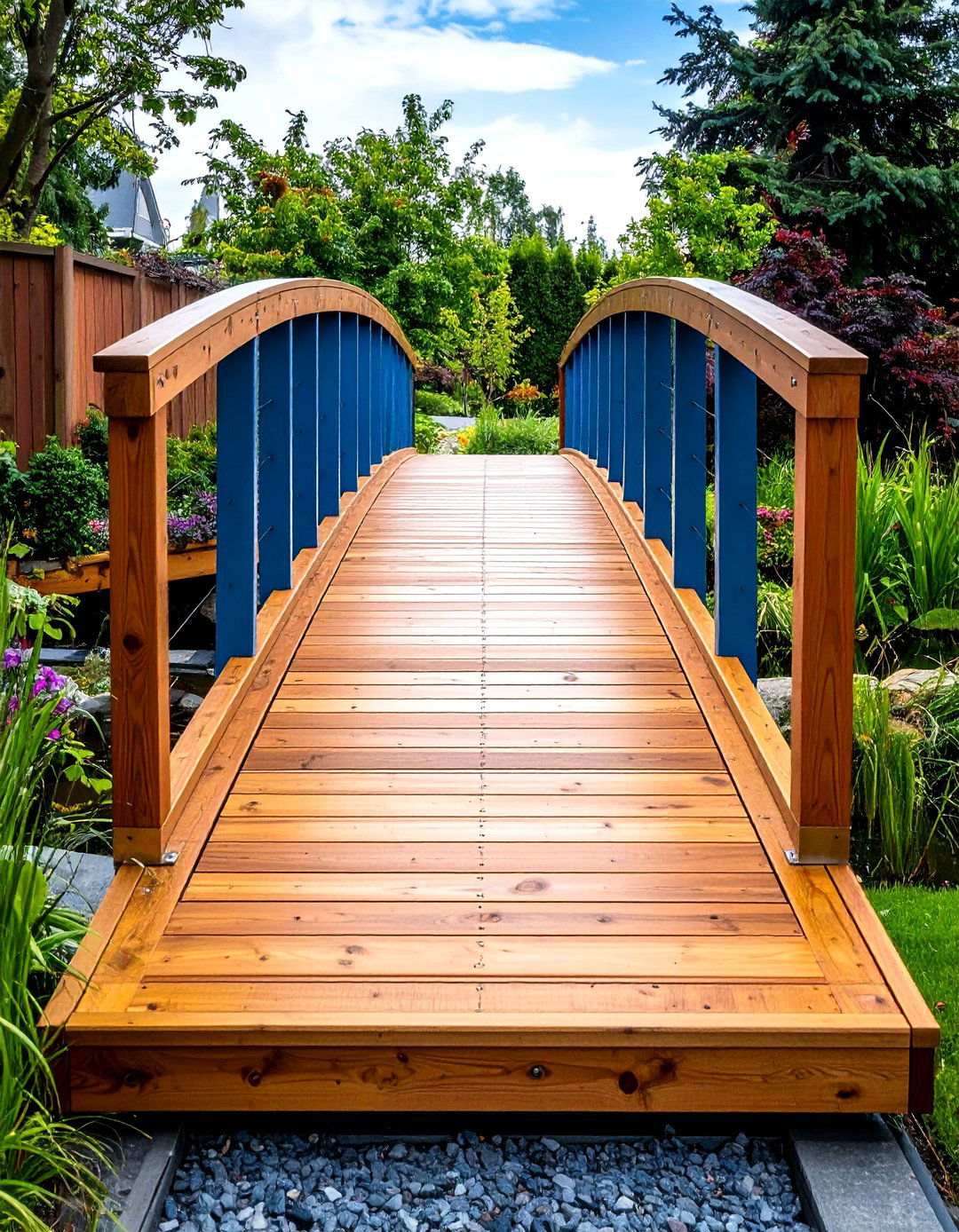
Where water levels fluctuate, mount a lightweight composite-deck bridge on hidden pontoons so it gently rises and falls. Position stainless guide rods through plastic sleeves cast into each bank to stop lateral drift. Tongue-and-groove deck boards prevent trip lips, and a slight outward camber encourages puddles to drain through side gaps. Because the structure never grounds out, pond-edge plants such as pickerel weed are protected from crushing. A slim stainless cable rail meets code yet preserves open sight-lines across shimmering reflections.
20. Smart Sensor-Illuminated Garden Bridge

Finally, weave tech into tranquility by fitting discreet motion sensors under the handrails. Pair them with dimmable LED strip so the garden bridge glows softly when wildlife moves and brightens as people approach. Many modern solar fixtures integrate Bluetooth modules for app-based control and dusk scheduling. Choose warm amber settings to minimise insect disruption and enable “moon mode” after midnight that drops output to 10 percent. Power cables tuck inside an anodised aluminium channel, keeping the deck surface clear. Add a small dashboard on your phone that logs crossing counts—handy for tracking nocturnal critter activity as well as human footfall.
Conclusion:
From living arches that photosynthesise overhead to corten sculptures that frame water like a piece of art, a garden bridge can be far more than a utilitarian cross-over. Material choices—from reclaimed pallet planks to flood-tough gabion bases—let you match budget, style, and site challenges while turning everyday journeys into sensory micro-adventures. Above all, each thoughtfully placed garden bridge stitches your outdoor story together, guiding guests (and wildlife) smoothly through light, fragrance, texture, and reflection so the whole landscape feels larger, richer, and more alive.


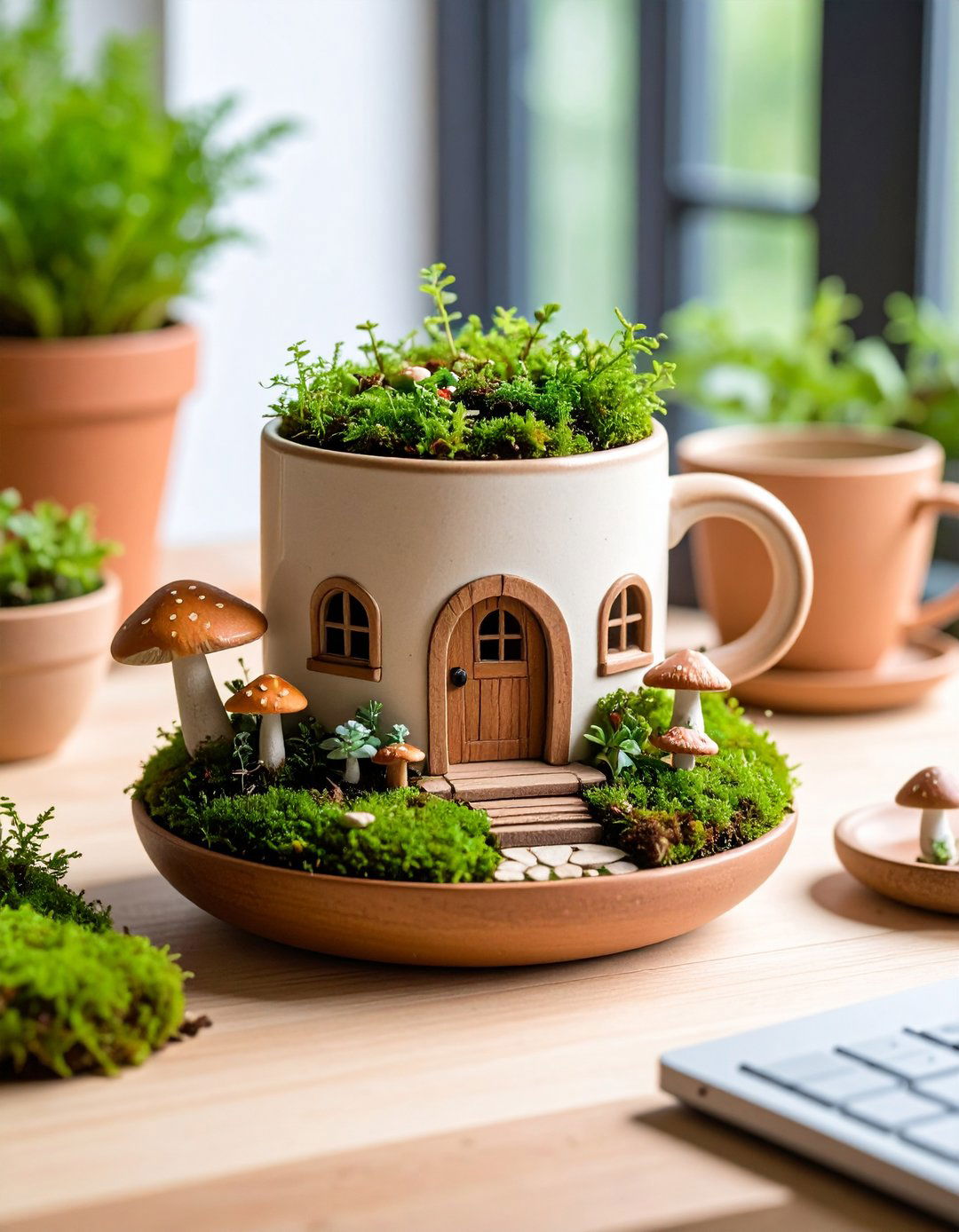
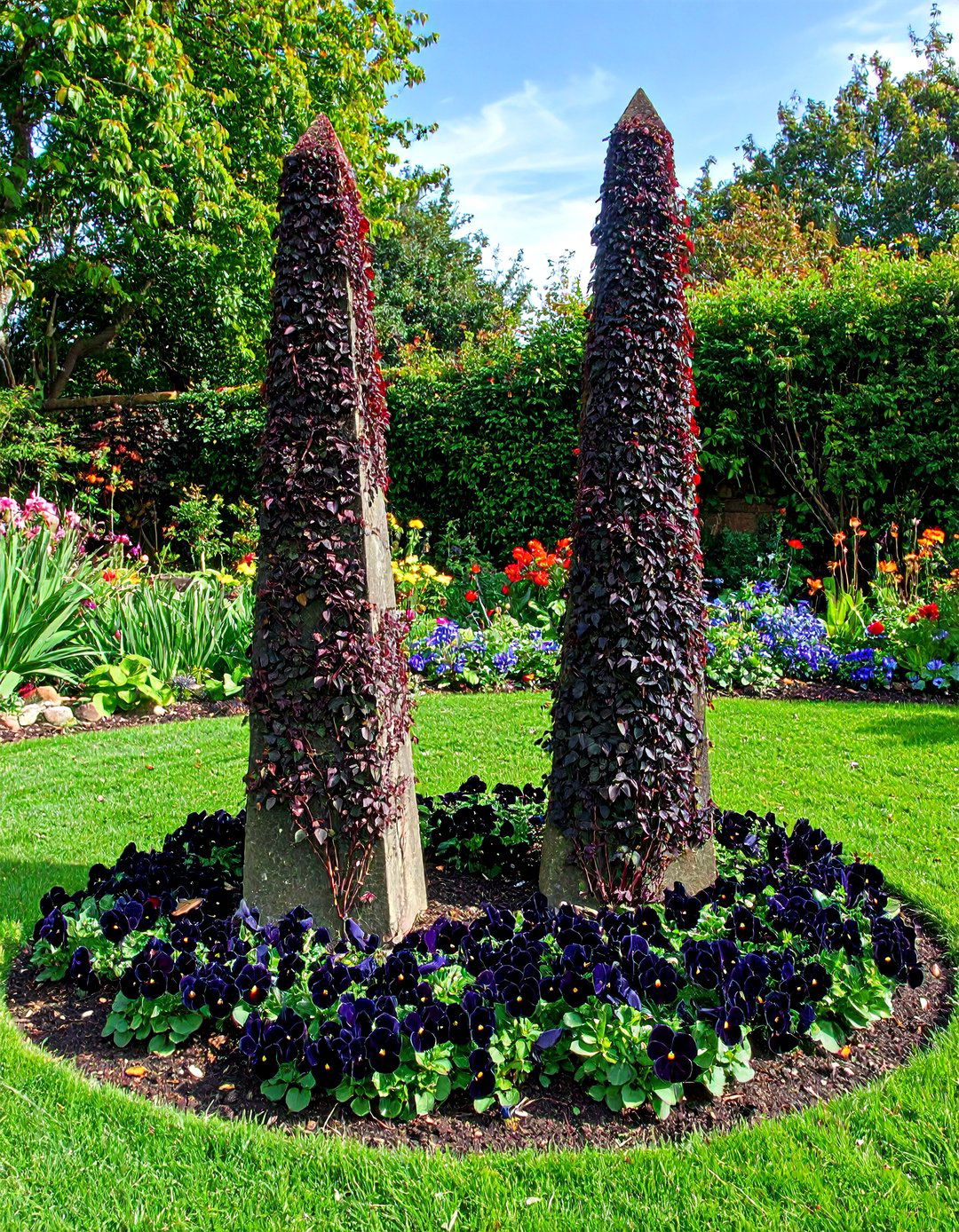
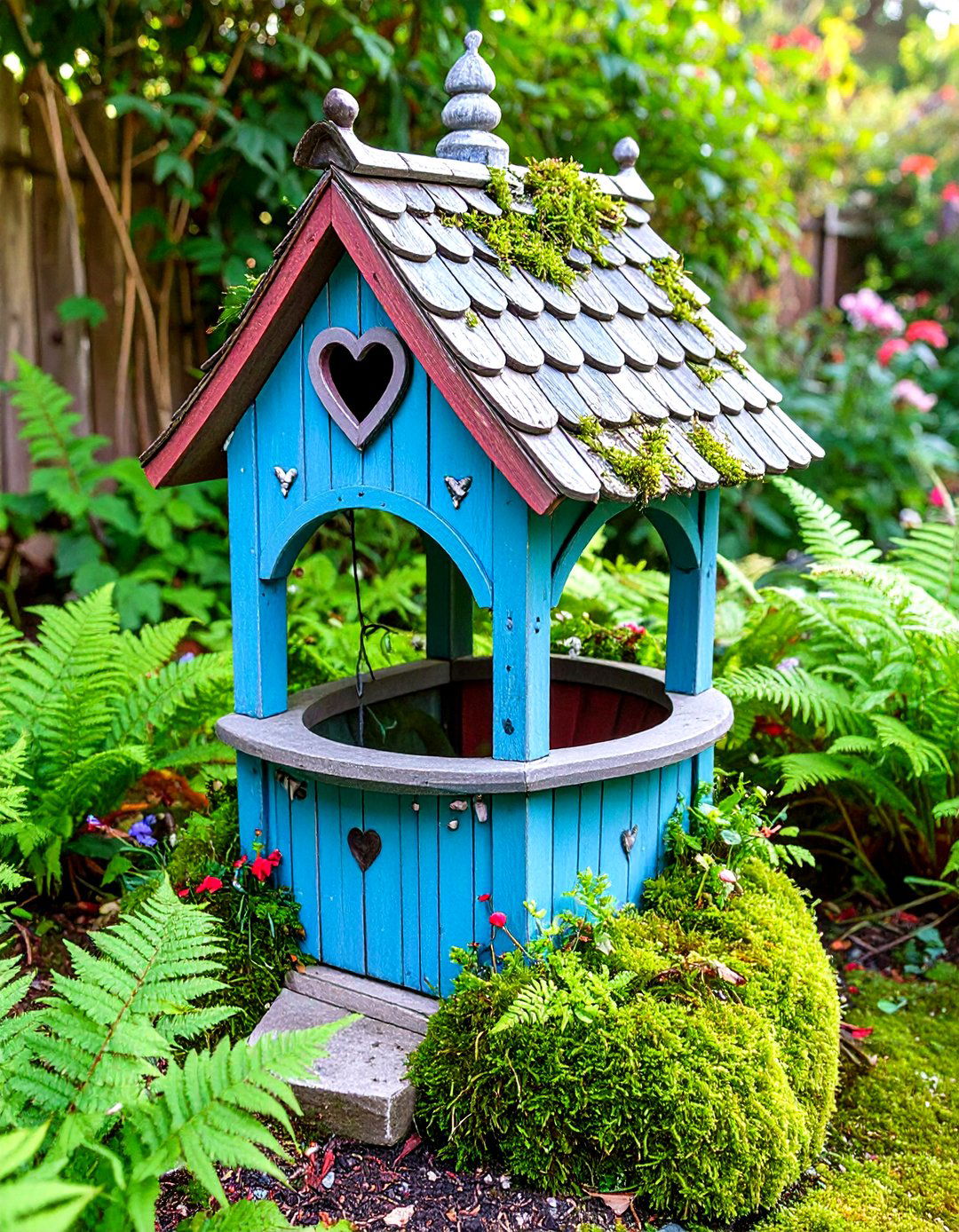

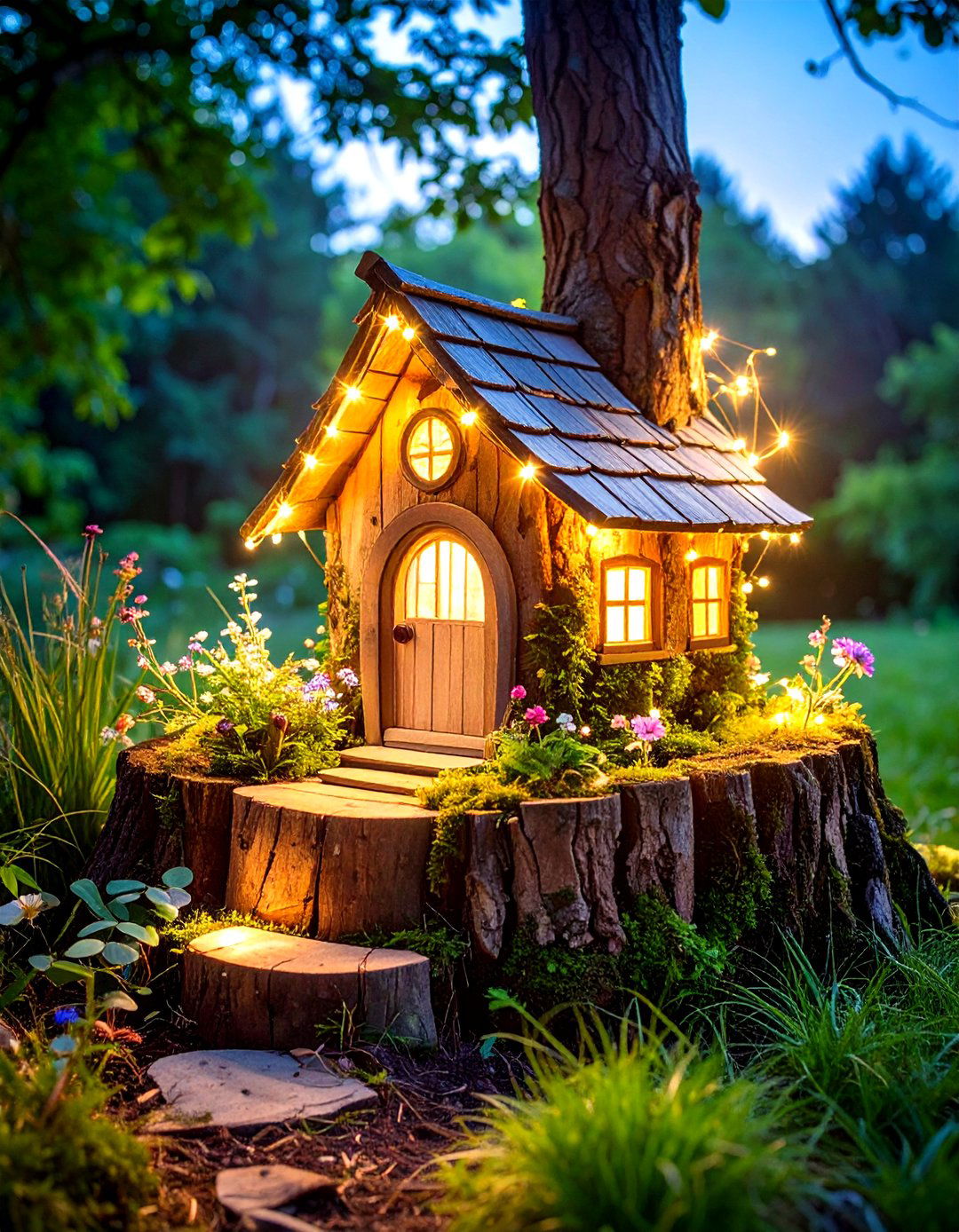
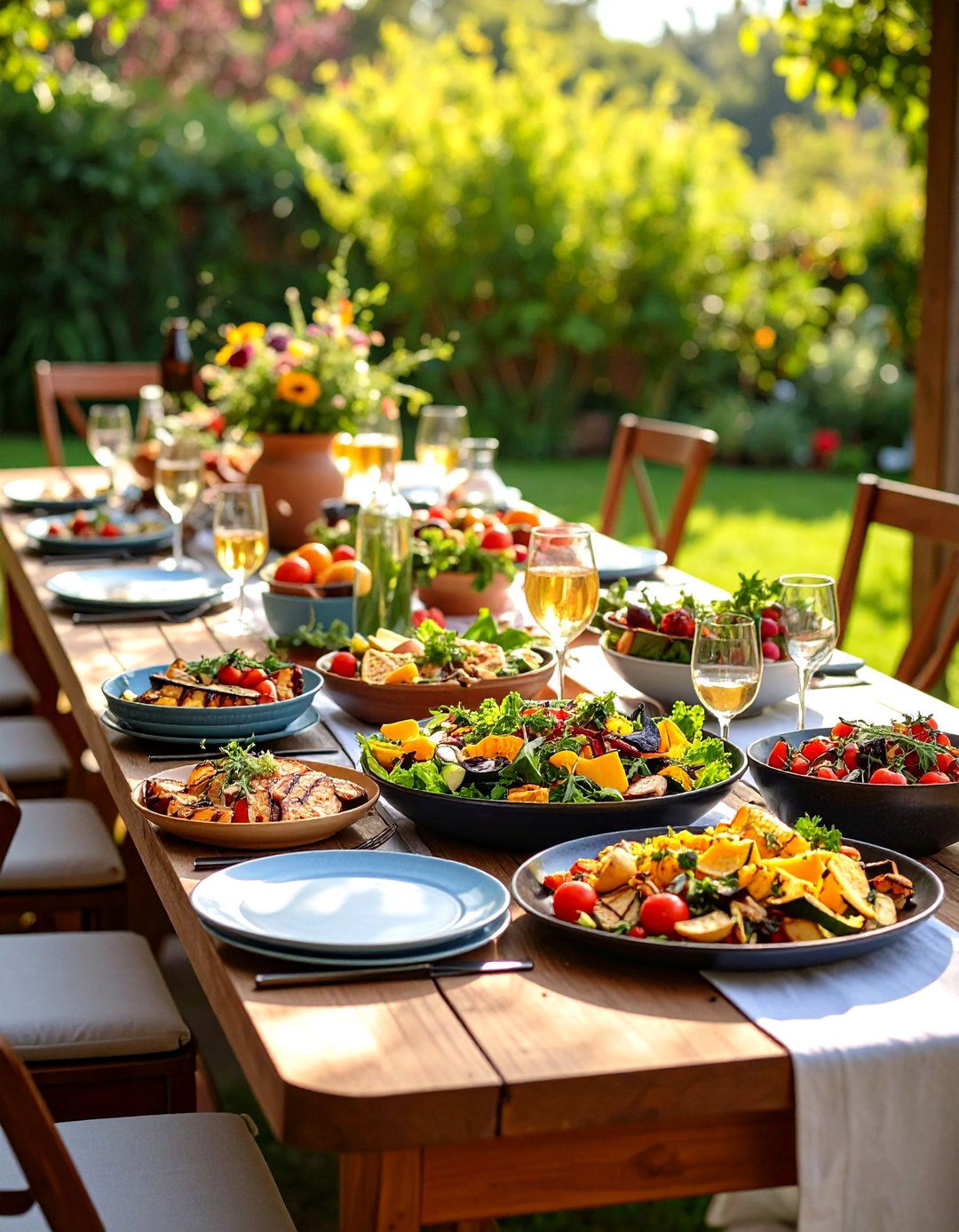


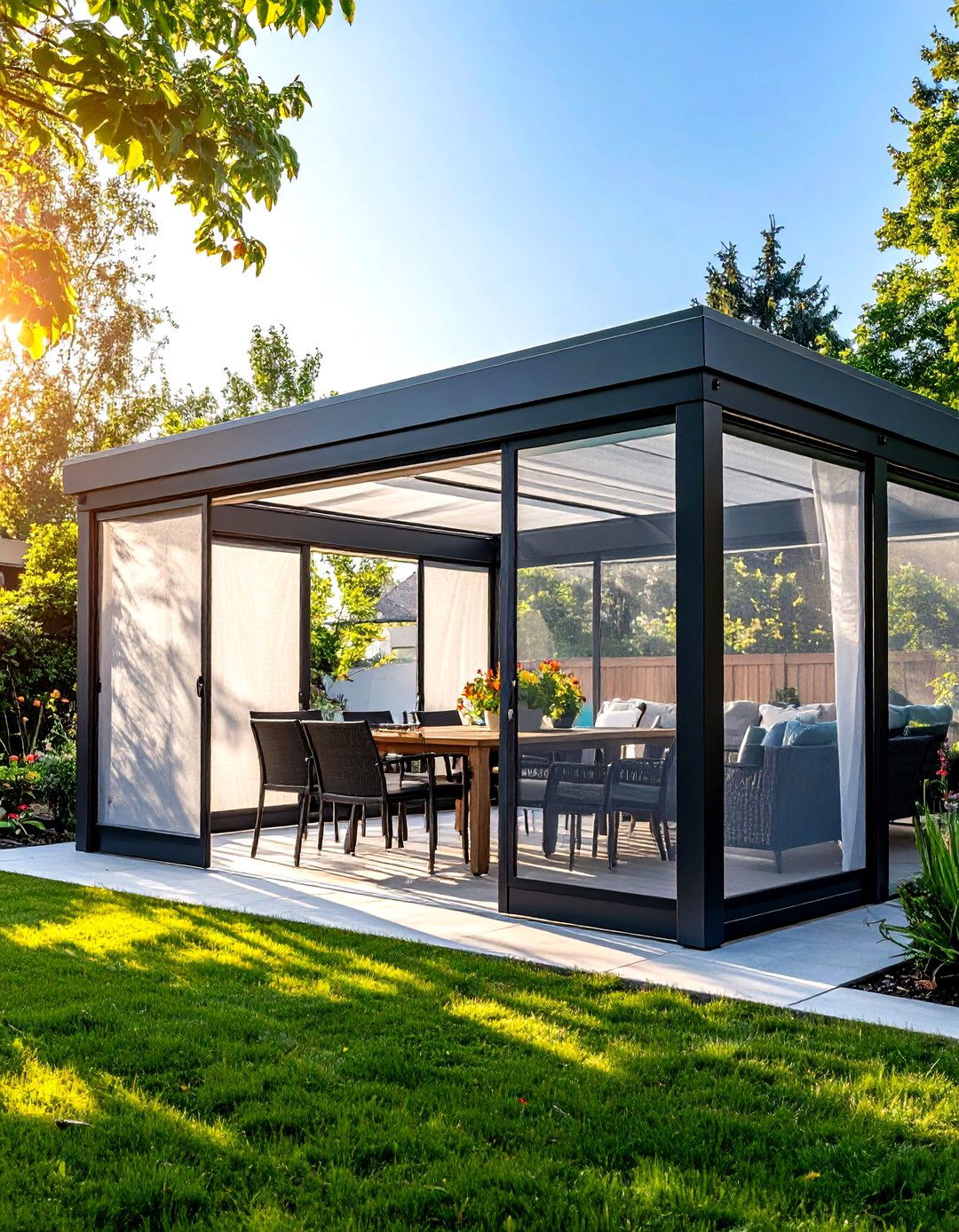



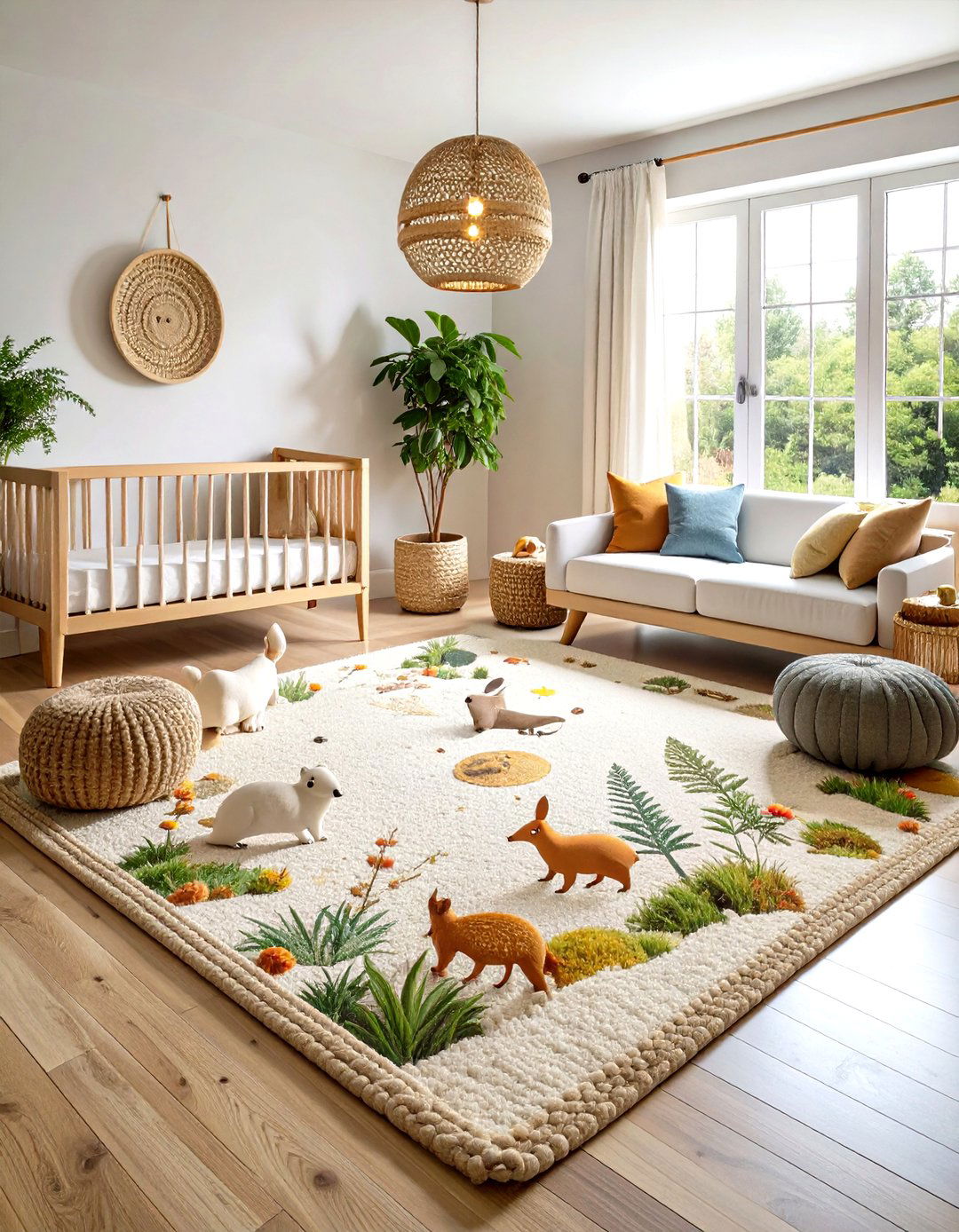

Leave a Reply